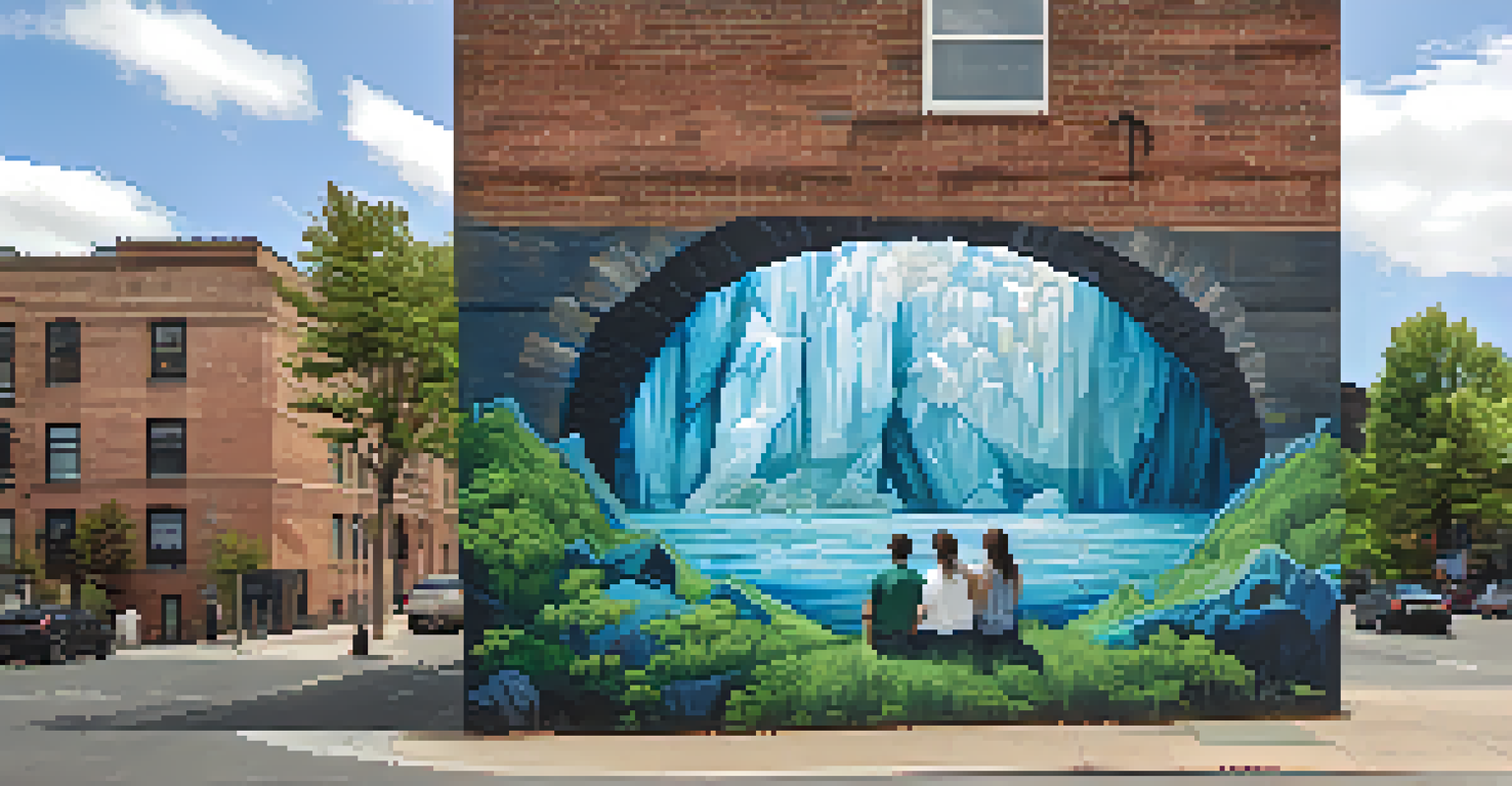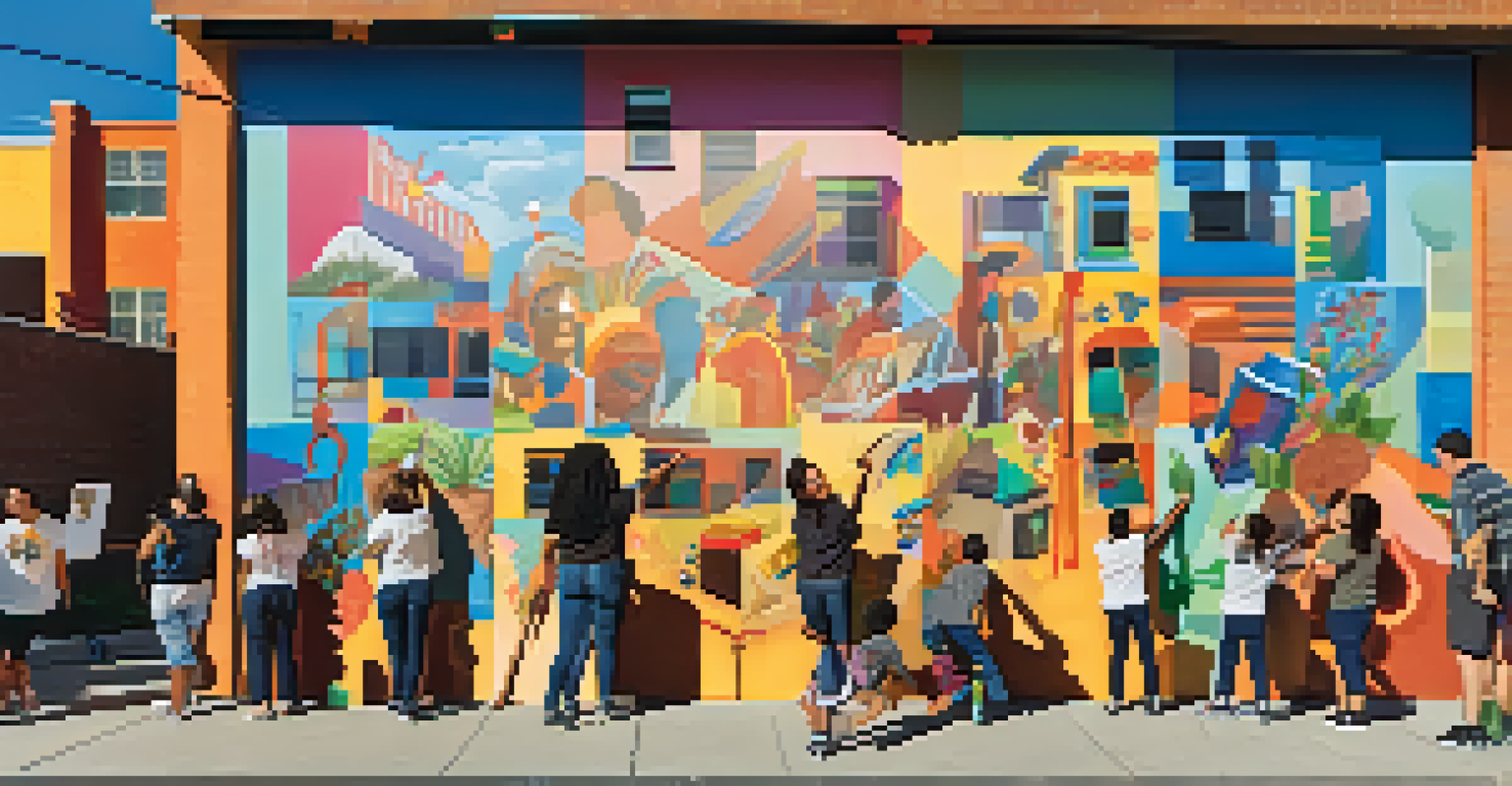Cultural Significance of Murals in Urban Environments Today

Murals as Expressions of Identity in Urban Spaces
Murals often serve as powerful expressions of local identity, showcasing the unique characteristics of a community. Through vibrant colors and intricate designs, these artworks tell stories about the people, history, and culture of the area. For example, a mural in a neighborhood with a rich immigrant history might depict the traditions and contributions of those groups, helping to preserve their legacy for future generations.
Public art can be a powerful tool for social change, sparking conversations and inspiring action.
In many cases, these murals give a voice to marginalized communities that may not have other platforms to share their stories. Artists often collaborate with local residents to ensure that the artwork authentically represents their experiences and perspectives. This process not only fosters a sense of pride but also strengthens community ties.
Ultimately, murals contribute to a sense of belonging and place, reminding residents of their shared history and cultural heritage. As people walk through their neighborhoods, these murals can evoke emotions and memories, transforming ordinary streets into vibrant cultural corridors.
Murals as Tools for Social Commentary and Activism
Urban murals often serve as a canvas for social commentary, addressing pressing issues such as inequality, racism, and environmental concerns. Artists use their work to raise awareness and provoke thought, making public art a powerful medium for activism. For instance, a mural depicting climate change impacts can inspire action and dialogue among viewers.

Through bold imagery and thought-provoking messages, these artworks challenge the status quo and encourage community engagement. They invite passersby to reflect on societal issues and consider their role in fostering change. This can lead to important conversations and mobilization around critical topics.
Murals Reflect Community Identity
Murals serve as powerful expressions of local identity, showcasing the unique stories, culture, and history of a community.
Moreover, murals can spark movements and campaigns, as they capture the public's attention and create a platform for discussion. By transforming walls into statements, artists can influence the narrative surrounding social justice, helping to shape a community's values and priorities.
Economic Impact of Murals in Urban Areas
Murals can have a significant economic impact on urban areas, attracting tourists and boosting local businesses. When people visit a city, they often seek out iconic murals, turning these art pieces into popular photo spots. This influx of visitors can lead to increased foot traffic for nearby shops, cafes, and galleries.
Art is the most beautiful of all lies; it is a representation of our identity and culture.
Additionally, cities that embrace public art often experience a rise in property values. Well-executed murals can beautify neighborhoods, making them more appealing to potential residents and investors. This can ultimately lead to urban revitalization, providing new opportunities for economic growth.
Furthermore, mural festivals and events can create jobs and promote local artists, fostering a vibrant creative economy. By investing in public art, cities can cultivate a unique identity that draws in both residents and visitors alike, making murals an integral part of urban development.
The Role of Community Engagement in Mural Creation
Community engagement plays a vital role in the creation of murals, ensuring that the artwork resonates with local residents. Artists often collaborate with community members to gather input and ideas, making the mural a collective expression rather than an individual vision. This collaborative process fosters a sense of ownership and pride among residents.
Workshops and meetings can serve as platforms for sharing stories and perspectives, allowing the mural to reflect the diverse voices within the community. This inclusivity not only enriches the artwork but also strengthens social bonds, bringing people together around a shared project.
Murals as Activism and Commentary
Urban murals function as platforms for social commentary, addressing critical issues and fostering dialogue among community members.
Moreover, when communities actively participate in the mural-making process, they are more likely to care for and protect the artwork. This stewardship helps to sustain public art projects and reinforces the importance of community identity, creating lasting connections between the people and their environment.
Murals and Cultural Preservation in Urban Settings
Murals often play a crucial role in preserving cultural heritage in urban environments. As cities evolve and gentrification occurs, these artworks serve as visual reminders of the past, celebrating traditions and histories that might otherwise be forgotten. They can highlight important figures, events, or practices that have shaped the community's identity.
By depicting cultural narratives, murals help to educate both residents and visitors about the local heritage. This can foster greater appreciation and respect for the diverse cultures that coexist in urban areas. For example, a mural celebrating indigenous traditions can raise awareness about their historical significance and contemporary relevance.
Additionally, murals can act as a bridge between generations, connecting older residents with younger ones through shared stories and experiences. This intergenerational dialogue helps to reinforce the importance of cultural preservation, ensuring that the community's history is honored and passed down.
The Evolution of Murals in the Digital Age
As technology advances, the way murals are created and shared has evolved dramatically. Digital tools and social media platforms allow artists to reach wider audiences, showcasing their work beyond the physical space of the mural. This increased visibility can lead to greater appreciation and support for public art initiatives.
Moreover, augmented reality (AR) is beginning to play a role in mural experiences, offering interactive elements that engage viewers in new ways. Imagine standing in front of a mural and using your smartphone to see animations or hear stories about the artwork—this fusion of technology and art can enhance the overall experience.
Economic Benefits of Urban Murals
Murals can boost local economies by attracting tourists, increasing property values, and promoting a vibrant creative culture.
However, while digital advancements offer exciting possibilities, it's essential to maintain the essence of murals as community-driven projects. Striking a balance between innovation and authenticity ensures that murals continue to reflect the values and stories of the communities they inhabit.
Challenges Facing Urban Murals Today
Despite their cultural significance, urban murals face several challenges in today's world. Issues such as vandalism, neglect, and gentrification can threaten the existence of these artworks. For example, a beloved mural may be painted over during a redevelopment project, erasing a piece of community history.
Additionally, funding and resources for public art initiatives can be limited, making it difficult for artists to secure materials and permissions. This can hinder the creation of new murals and the maintenance of existing ones, reducing their impact on the community.

To combat these challenges, it's crucial for communities and local governments to advocate for the importance of public art. By supporting artists and prioritizing mural projects, cities can ensure that these vibrant expressions of culture and identity continue to thrive in urban environments.